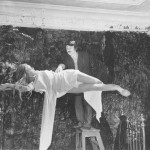Category: Words
-
Speaking of Writing
Six years ago when I was writing my Master’s thesis, I contacted Michael Chabon via his Website, and he was gracious enough to answer my questions (and my follow ups) over the course of a week or two.
-
The Good Woman of Setzuan
Several years later I read Mother Courage in a performance theory seminar, and his seemed to me an interesting, if too rigidly intellectual, project. Now, at 31 and with my political positions in something of a flux, I think I’m finally ready to really read Brecht.
-
A Good Read
On Saturday, on that plane, I was reading Illuminations, a collection of “Essays and Reflections” by Walter Benjamin, the influential, early-20th century German literary critic.
-
Snippets
Two quotes from Tony Kushner.
-
Kushner on Bush
Tony Kushner on President Bush and military intervention in Iraq.
-
Rilke’s “The Man Watching”
Less than an hour until President Bush’s national address, and I’m too tired, too frustrated, and too stunned to think. I know that there’s not much lower on the blog food chain than posting a poem without comment, but, well, a friend sent this to me today, and it’s been a source of welcomed comfort.
-
Let America Be America Again
So, it turns out that Laura Bush just cancelled a planned poetry celebration after learning that one of the invited speakers had encouraged his colleagues to use the event as an opportunity to publicly denounce war on Iraq.
-
The Rise and Fall of the American Left (1992)
By John Patrick Diggins For Diggins, the first problem facing any historian of the American Left is one of basic terminology. “The characteristics most often used to define the Left,” he writes, “the demand for change; political ideals like justice, equality, and democracy; anticapitalism and the tactic of dissent; the mentalities of rationalism and ideology—are […]
-
The Agony of the American Left
Spanning the years from the Populist movement of the 1890s to the radical politics of the 1960s, Lasch’s study offers a useful analysis of many of the social, economic, and political forces that have combined to frustrate the American Left in its search for a politically potent mixture of theory and action.
-
Homebody/Kabul
Instead of beginning my dissertation prospectus, which really should be occupying a larger chunk of my life right now, I’ve discovered all sorts of distractions that can be justified away as “research.”
-
Patrick Marber
I spent last evening — which, like tonight, was cold and rainy — wrapped up on our living room love seat, reading two fantastic plays by a young British writer named Patrick Marber.
-
Angels in Phoenix
I’ll eventually get around to writing (much) more about this, but I want to mention quickly that, while vacationing in Phoenix, Joanna and I had the chance to see Tony Kushner’s Angels in America at the Herberger Theater.
-
Life at War
If there’s such thing as a truly legitimate call for the use of art as a practical means to change the world, then it will probably never find a more sure voice than Denise Levertov’s.
-
The Culture of the Cold War (1991)
The Culture of the Cold War is divided into chapter-long studies of the major voices of popular culture, each of which, according to Whitfield, reflected and contributed to the polarity that characterized so much of the 1950s.
-
American Pastoral (1997)
What most fascinates me about this novel—along, of course, with Roth’s beautiful prose—is its inability, ultimately, to make any sense of the Swede’s tragedy.
-
Black Water (1992)
But Black Water is first and foremost a novel about Kelly Kelleher and, by analogy, all other women who have been abused, exploited, and discarded by the powerful and by the media that report it.
-
American Fiction in the Cold War
Schaub focuses the majority of his attention on the early post-war years, turning to the New York Intellectuals—Howe, Trilling, and Schlesinger, in particular—for his diagnosis of the crisis at the heart of the American Left at the start of the Cold War.
-
The Public Burning (1976)
At the site of the execution—fantastically transposed from Sing Sing to the middle of Times Square—Nixon appears with his pants around his ankles, fully erect, then brings the crowd to a riotous frenzy as history dissolves around them.
-

Benito Cereno (1855)
As Mike Frank has recently asked, “What might narratology look like if we were to take cinema — particularly ‘classical Hollywood cinema’ — as the paradigmatic instance of storytelling?”
-
The Woman Warrior (1975)
Reading The Woman Warrior now, twenty-five years after its original publication, I find it difficult to separate the actual text from the cultural milieu in which it was written.
-
Another Country (1962)
Baldwin is so determined to explode the intersections of race, gender, and sexuality that he makes a fatal mistake: instead of being particularly insightful or even shocking, Another Country is preachy, sentimental, and, worst of all, boring.
-
Broom of the System (1987)
Lenore Beadsman’s life is complicated. The 24 year old heir to the Beadsman baby food empire struggles to balance her career as a call center operator — where the lines of communication seem perpetually crossed — with her, um, complex relationship with her boss, Rick Vigorous, of Frequent and Vigorous Publishing.
-
Their Eyes Were Watching God (1937)
In the opening chapters of Their Eyes Were Watching God, an elderly African-American woman sits down with her granddaughter and explains the main lesson she has learned during her difficult life, one that has spanned from the final years of slavery to the more promising days of the twentieth century.
-
O Pioneers (1913)
Willa Cather was nearly 40 years old in 1913 when she published O Pioneers!, her second novel. It’s difficult, then, to overlook the obvious similarities between her own life and that of her heroine, Alexandra Bergson.
-

Sculpting in Time
I’ve never read another book like Sculpting in Time. In it Tarkovsky speaks as eloquently about art as he does faith and philosophy, and does so in a remarkably kind, concerned voice.
-
Sculpting in Time (1987)
I’ve never read another book like Sculpting in Time. In it Tarkovsky speaks as eloquently about art as he does faith and philosophy, and does so in a remarkably kind, concerned voice. To him, his subject —the unique ability of the cinematic image to touch the soul and inspire spiritual improvement — is quite literally a matter of life and death.
-
New Seeds of Contemplation (1961)
Like “Making Peace,” the Denise Levertov poem that inspired this site, Thomas Merton’s New Seeds of Contemplation is concerned with the destructive influences of greed, superficiality, and passivity on our hectic, disjointed lives.
-
The Films of Andrei Tarkovsky: A Visual Fugue (1994)
Johnson’s and Petrie’s study is that extremely rare beast: an academic study that is informative, objective (or as close as anyone can get), and readable.
-
Double Lives, Second Chances: The Cinema of Krzysztof Kieslowski (1999)
Insdorf sets out with the right questions in mind: How was Kieslowski’s body of work shaped by personal experience, particularly by his life under Communism? What other directors, artists, and thinkers shaped his aesthetic? What preoccupations, both ideological and stylistic, form the backbone of his work? What precipitated his move from documentary to narrative film, and how did each influence the other? Unfortunately, in attempting to answer all of these questions (and in only 180 pages), she fails to address any of them adequately.
-
Buried Child (1978)
With his return, Vince takes on his legacy, the house itself and the secrets buried around and within it. He also takes on its pain.